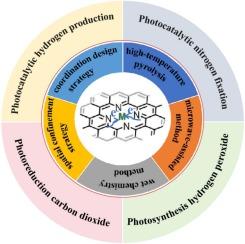当前位置:
X-MOL 学术
›
Coord. Chem. Rev.
›
论文详情
Our official English website, www.x-mol.net, welcomes your
feedback! (Note: you will need to create a separate account there.)
Metal-nitrogen coordinated single atomic photocatalysts for solar energy conversion
Coordination Chemistry Reviews ( IF 20.3 ) Pub Date : 2024-10-15 , DOI: 10.1016/j.ccr.2024.216254 Yiqiao Wang, Liling Liao, Gangqiang Zhu, Weiqiang Xie, Qian Zhou, Fang Yu, Hongpeng Zhou, Haiqing Zhou
Coordination Chemistry Reviews ( IF 20.3 ) Pub Date : 2024-10-15 , DOI: 10.1016/j.ccr.2024.216254 Yiqiao Wang, Liling Liao, Gangqiang Zhu, Weiqiang Xie, Qian Zhou, Fang Yu, Hongpeng Zhou, Haiqing Zhou

|
The utilization of solar energy to synthesize fuels offers a promising and sustainable solution for energy storage, but inefficient utilization of the solar spectrum and inadequate charge separation currently hinder its commercial viability. Designing and developing efficient photocatalytic materials are fundamental to achieve high energy conversion efficiency. Single atom catalysts (SACs), with well-defined single atoms (SAs) as active sites, have demonstrated excellent intrinsic activity, high atomic utilization efficiency, and a well-understood structure-activity relationship. These catalysts are widely applied in photocatalytic H2 evolution, photoreduction of CO2 , photofixation of N2 and photocatalytic H2 O2 production. Importantly, compared to other elements, the unpaired electrons of nitrogen atoms are more readily bonded with metal atoms and subsequently form M-N based SACs. In this review, we will present a systematical overview of the synthetic approaches of M-N based SACs in photocatalysis and also discusses the effect of SACs modifications on light responsiveness, carrier transfer dynamics and surface reaction efficiency in photocatalytic systems. Then, we propose the key principles of SACs design and photocatalytic applications based on recent advancements. Finally, we discuss the major challenges and potential opportunities that lie ahead in the development of SACs.
中文翻译:

用于太阳能转换的金属-氮配位单原子光催化剂
利用太阳能合成燃料为储能提供了一种有前途且可持续的解决方案,但太阳能光谱的低效利用和电荷分离不充分目前阻碍了其商业可行性。设计和开发高效的光催化材料是实现高能量转换效率的基础。单原子催化剂 (SAC) 以明确定义的单原子 (SA) 为活性位点,表现出优异的本征活性、高原子利用效率和众所周知的构效关系。这些催化剂广泛应用于光催化 H2 释放、CO2 光还原、N2 光固定和光催化 H2O2 生产。重要的是,与其他元素相比,氮原子的不成对电子更容易与金属原子键合,随后形成基于 M-N 的 SAC。在这篇综述中,我们将系统地概述基于 M-N 的 SACs 在光催化中的合成方法,并讨论 SACs 修饰对光催化系统中光响应性、载流子转移动力学和表面反应效率的影响。然后,我们根据最近的进展提出了 SACs 设计和光催化应用的关键原理。最后,我们讨论了 SAC 发展中面临的主要挑战和潜在机遇。
更新日期:2024-10-15
中文翻译:

用于太阳能转换的金属-氮配位单原子光催化剂
利用太阳能合成燃料为储能提供了一种有前途且可持续的解决方案,但太阳能光谱的低效利用和电荷分离不充分目前阻碍了其商业可行性。设计和开发高效的光催化材料是实现高能量转换效率的基础。单原子催化剂 (SAC) 以明确定义的单原子 (SA) 为活性位点,表现出优异的本征活性、高原子利用效率和众所周知的构效关系。这些催化剂广泛应用于光催化 H2 释放、CO2 光还原、N2 光固定和光催化 H2O2 生产。重要的是,与其他元素相比,氮原子的不成对电子更容易与金属原子键合,随后形成基于 M-N 的 SAC。在这篇综述中,我们将系统地概述基于 M-N 的 SACs 在光催化中的合成方法,并讨论 SACs 修饰对光催化系统中光响应性、载流子转移动力学和表面反应效率的影响。然后,我们根据最近的进展提出了 SACs 设计和光催化应用的关键原理。最后,我们讨论了 SAC 发展中面临的主要挑战和潜在机遇。


















































 京公网安备 11010802027423号
京公网安备 11010802027423号